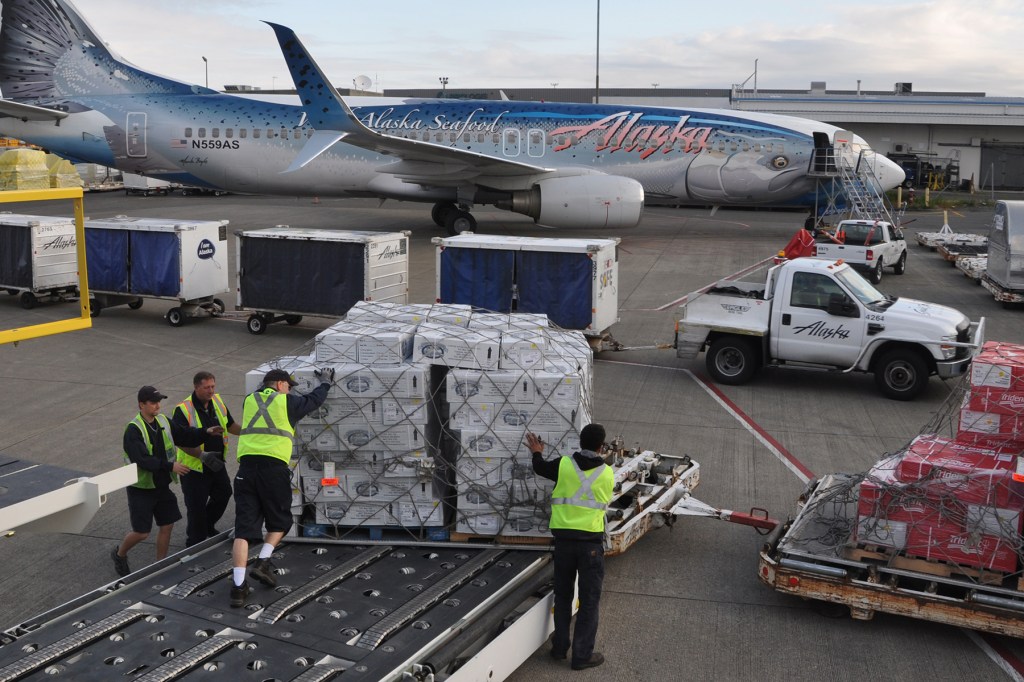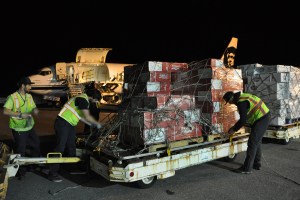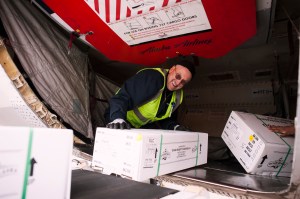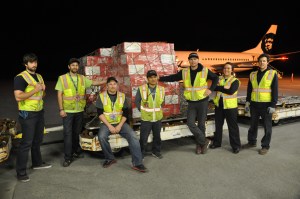Flying fish: This is how Alaska Airlines delivers the catch of the day, every day
Share

Alaska Air Cargo employees in Seattle offload boxes of salmon from Cordova, Alaska.
To help kick off the summer fishing season around Bristol Bay, Alaska Airlines on Sunday will resume its daily Boeing 737 flights to deliver hundreds of sport fishermen and commercial seafood processors to the tiny Alaska towns of Dillingham and King Salmon. Every year, Alaska launches seasonal jet service to support the workers and tourists who fly in and out of the fishing towns throughout the summer.
While Alaska’s air service to Dillingham and King Salmon is seasonal, the airline’s support of the seafood industry continues year-round in places such as Kodiak, Anchorage, Sitka and Seattle, to name just a few.
On the ground, the hard work of Alaska Air Cargo employees keeps seafood moving around the clock, 365 days a year. That takes a huge amount of planning and coordination, especially when transporting fresh seafood.
“When those boats start coming in, it’s all hands on deck,” said Shannon Stevens, Alaska’s seafood cargo sales manager known as the Fish Lady. “It’s really important that we move the fish out as soon as possible.”
Bring on the fish!
 The quickness is important not only for freshness, but also for price – the first few fish of a season are worth the most, then the price goes down as supply catches up with demand.
The quickness is important not only for freshness, but also for price – the first few fish of a season are worth the most, then the price goes down as supply catches up with demand.
Alaska Airlines plays a significant role in supporting the Alaska seafood industry, which accounts for about 60 percent of total U.S. domestic seafood production by volume, according to a February 2015 report “Ties that Bind: The Enduring Economic Impact of Alaska on the Puget Sound Region.” The economic impact extends all the way to Seattle – nearly 24,000 Puget Sound jobs and $1.3 billion in labor earnings are tied to Alaska’s seafood industry, the report says.
“What I love about this time of year is the amazing teamwork and personal care given by our employees in handling this valuable commodity,” said Betsy Bacon, managing director of Alaska Air Cargo. “It is just one example of our ‘Alaska Spirit’ but an incredibly important one. Thank you to everyone who plays a role in keeping our seafood cool, keeping it fresh and keeping it moving!”
For employees in Alaska, that means working late nights and early mornings during the height of a season.
“We’re always excited for the first opener,” said Kyle King, a lead ramp agent in Cordova who has worked past summers as a crew member on his dad’s commercial fishing boat. “At the airport, the first week is always busy with fishermen, cannery workers and a lot of other people related to the industry. It’s hustle and bustle.”
Keep it moving, fast and fresh
 Of the 25 million pounds of seafood that Alaska Air Cargo delivered last year, 19 million pounds came from state of Alaska – a lot of salmon, but also halibut, cod and live crab.
Of the 25 million pounds of seafood that Alaska Air Cargo delivered last year, 19 million pounds came from state of Alaska – a lot of salmon, but also halibut, cod and live crab.
Beyond Alaska, Air Cargo ships tuna from Hawaii, lobster and scallops from Boston, salmon and crab from the Bay Area, tuna and swordfish from San Diego and Los Angeles, and oysters and clams from Seattle.
“Communication is the key,” Stevens said. “It takes everyone in every part of our airline – from the scheduling folks to the load planning folks to our booking agents to the individual stations, and everyone in between.”
Of all of the Alaska Airlines stations, employees in Kodiak hooked this year’s coveted “Codfather” award for originating the most seafood: more than 3.6 million pounds in 2014.
Since fishing seasons rotate throughout the year, there’s always something in season.
The goal is to keep seafood moving quickly and maintain a consistent temperature range throughout its journey. Every Alaska employee who handles seafood is required to pass a yearly cool-chain training class. The strict quality standards ensure that fresh fish arrives at markets and restaurants as fresh as possible.
Seafood seasons in Alaska
COD: January-March
Jan. 1 starts off cod season out of Kodiak, and that usually goes through March. It picks up again in fall.
LIVE KING CRAB: January-May
For the first time, Alaska Air Cargo began regular shipments of live king crab out of Adak this season, which runs the third week of January through mid-May. It’s a 3.5-hour trip from Adak into Anchorage, then the plane heads south to Seattle.
HALIBUT: March-November
Halibut season opens the second week of March and goes until the first week of November, in places from Adak to Kodiak and throughout Southeast Alaska.
“Fishermen often start their season fishing for this high-dollar catch, then change their gear to go salmon fishing June to August before changing back to halibut to clean up the remaining quota,” Stevens said
SALMON: Mid-May-June, with some winter openers
The summer salmon season opens with the Copper River catch out of Cordova in mid-May. From June through September, salmon show up throughout Southeast Alaska and Kodiak. Some openers continue through the winter with king salmon out of Southeast.
GEODUCK: September-February
Geoduck clam season opens as early as September in Sitka. Ketchikan starts diving the first week of October through Chinese New Year in February.





